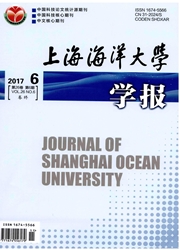

 中文摘要:
中文摘要:
为探讨坛紫菜(Pyropia haitanensis)种间杂交的可行性,进一步选育坛紫菜新品系,以野生型坛紫菜作为母本,以采自印度的Pyropia radi作为父本进行种间杂交,并以亲本叶状体细胞的液泡大小与色素体的大小和颜色作为遗传标记:母本的细胞内液泡较小,具一个较大的色素体,颜色偏红;父本的细胞内具有一个很大的液泡,但色素体较小,颜色偏褐带黄。杂交实验结果如下:依据液泡体积、色素体的大小和颜色区分,在F1叶状体中出现了6种类型的细胞:2种亲本细胞类型,4种杂交重组细胞类型,它们分别为母本型(Ph),父本型(Pr),似母本型(Ph′,液泡大小与Ph相同,但色素体偏黄),似父本Ⅰ型(Pr′,液泡比Pr小,且色素体偏红),似父本Ⅱ型(Pr″,液泡大小介于Pr和Pr′之间,且色素体颜色比Pr′更浅),似父本Ⅲ型(Pr,液泡大小与Pr相同,但色素体稍黄)。这6种细胞在F1叶状体上出现分离,并呈块状直线排列。在F1叶状体中出现大量由2~4个色块构成的颜色嵌合体和少数单色的叶状体。上述结果证实这两种紫菜的种间杂交是成功的,并且F1叶状体是成活和可育的,为今后选育种间杂交新品种奠定了基础。
 英文摘要:
英文摘要:
In order to verify the practicability of interspecies cross between Pyropia haitanensis and other Pyropia, cross experiment between P. haitanensis from the temperate water of China and P. radi from the tropical water of India was carried out in the laboratory, marked with the color and size of the vacuoles and the chloroplasts in cells of parental blades. P. haitanensis was used as female parent, and its blades show brown green with an obvious pigment in cells of blades. P. radi was used as male parent, and its blades show brown in color and the cells of blades containing a large vacuole and small chloroplasts. Among the F1 gametophytic blades from the cross of P. haitanensis (♀) × P. radi (♂), two parental colors (Ph and Pr) and four new colors (Ph′, the size of the vacuole similar to Ph and the color of the chloroplasts slightly yellower than Ph; Pr′, the size of the vacuole smaller than Pr and the color of the chloroplasts redder than Pr; Pr″, the size of the vacuole between Pr and Pr′ and the color of the chloroplasts lighter than Pr′; Pr, the size of the vacuole similar to Pr and the color of the chloroplasts slightly yellower than Pr) appeared. Linear segregation of colors occurred in the F1 blades, and therefore, the color sectored blades with 2-4 sectors were formed. There were a large number of color sectored blades and a few of single color blades. These results indicate that the interspecies cross between P. haitanensis and P. radi succeeded and the F1 gametophytic blades could survive and be fertile,which laid the foundation for the further selection of the new strains.
 同期刊论文项目
同期刊论文项目
 同项目期刊论文
同项目期刊论文
 期刊信息
期刊信息
